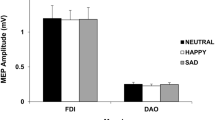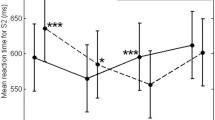Abstract
Lip protrusion requires bilateral symmetrical movements of the facial muscles, but the laterality of the activated sensorimotor cortex corresponding to the area of the face activated during lip protrusion remains under discussion. In this study, blood-oxygenation-level-dependent (BOLD) responses in the sensorimotor cortex during non-verbal lip protrusion were evaluated in a 3T magnetic field in twenty healthy right-handed subjects. The results showed that the activated sensorimotor area on the left side was larger than that on the right side, and there was a statistically significant difference in the number of activated voxels between the left and right sensorimotor cortex in an individual study of the male group, although approximately symmetrical motor action potentials of facial muscles were recorded during lip protrusion. There was a statistically significant difference in interaction between the hemisphere (right and left) and sex (men and women) and multiple comparison test showed statistical significant differences between “men and right” and “men and left”, and between “men and left” and “women and left”. The peak value of the percent changes in BOLD signal responses on the left side was approximately twice as high as that on the right side in the males of the group, though the bilateral sensorimotor cortex was almost equally activated in the females in the group. In addition, the left primary sensory area related to the face area was significantly activated as a region where Male was more active than Female in a general linear model (multi-study, multisubject) analysis. This study revealed the possibility that the left sensorimotor cortex was more closely involved in non-verbal mouth movement in men, suggesting sex-related differences in sensorimotor cortex activation.





Similar content being viewed by others
References
Confield DR, Murphy K, Josephs O, Fink GR, Frackowiak RS, Adams L, Turner R (1999) Cortical and subcortical control of tongue movement in humans. A functional neuroimaging study using fMRI. J Appl Physiol 86:1468–1477
Foki T, Geissler A, Gartus A, Pahs G, Deecke L, Beisteiner R (2007) Cortical lateralization of bilateral symmetrical chin movements and clinical relevance in tumor patients—a high field BOLD-FMRI study. Neuroimage 37:26–39
Goebel R (1996) Brainvoyager: a program for analyzing and visualizing functional and structural magnetic resonance data sets. Neuroimage 3:604
Goebel R, Khorram-Sefat D, Hacker H, Singer W (1996) Going beyond the information given, the neuronal substrate of phi-motion and shape-form-motion as revealed by functional magnetic resonance imaging. NeuroReport 3:174
Hesselmann V, Sorger B, Lasek K, Guntinas-Lichius O, Krug B, Sturm V, Goebel R, Lackner K (2004) Discriminating the cortical representation sites of tongue and lip movement by functional MRI. Brain Topo 16:159–167
Higashino K, Kunihiro T, Goto F, Kanzaki S, Hayashi Y, Honda S, Ogawa I (2002) Magnetoencephalography preceding the task of lip protrusion. Facial N Res. Jpn 22:79–81 (in Japanese)
Ikezawa S, Nakagome K, Mimura M, Shinoda J, Itoh K, Homma I, Kamijima K (2008) Gender differences in lateralization of mismatch negativity in dichotic listening tasks. Int J Psychophysiol 68:41–50
Ishikawa M, Ohira T, Namiki J, Gotoh K, Takase M, Toya S (1996) Electrophysiologic investigation of facial spasm: F-waves of the facial muscles. Acta Neurochir (Wien) 138:24–32
Ishikawa M, Namiki J, Takase M, Kojima A, Kawase T (1999) F-waves of the facial muscles in healthy control subjects and in patients with peripheral facial nerve disturbance. Electromyogr Clin Neurophysiol 39:167–174
Kern M, Birn R, Jaradeh S, Jesmanowicz A, Cox R, Hyde J, Shaker R (2001) Swallow-related cerebral cortical activity maps are not specific to deglutition. Am J Physiol Gastrointest Liver Physiol 280:G531–G538
Kimura D, Watson N (1989) The relation between oral movement control and speech. Brain Lang 37:565–590
Lotze M, Seggewies G, Erb M, Grodd W, Birbaumer N (2000) The representation of articulation in the primary sensorimotor cortex. NeuroReport 11:2985–2989
Nowicka A, Fersten E (2001) Sex-related differences in interhemispheric transmission time in the human brain. NeuroReport 12:4171–4175
Ogawa S, Lee TM, Kay AR, Tank DW (1990a) Brain magnetic resonance imaging with contrast dependent on blood oxygenation. Proc Natl Acad Sci USA 87:9868–9872
Ogawa S, Lee TM, Nayak AS, Glynn P (1990b) Oxygenation sensitive contrast in magnetic resonance image of rodent brain at high magnetic fields. Magn Reson Med 14:64–78
Oldfield RC (1971) The assessment and analysis of handedness: the Edinburgh inventory. Neuropsychologia 9:97–114
Riecker A, Ackermann H, Wildgruber D, Meyer J, Dogil G, Haider H, Grodd W (2000) Articulatory/phonetic sequencing at the level of the anterior perisylvian cortex. A functional magnetic resonance imaging (fMRI) study. Brain Lang 75:259–276
Rippon G (1990) Individual differences in eletrodermal and electroencephalographic asymmetries. Intern J Psycophysiol 8:309–320
Salmelin R, Sams M (2002) Motor cortex involvement during verbal versus non-verbal lip and tongue movements. Hum Brain Mapping 16:81–91
Schmidt KL, VanSwearingen JM, Levenstein RM (2005) Speed, amplitude, and asymmetry of lip movement in voluntary puckering and blowing expressions: implications for facial assessment. Motor Control 9:270–280
Talairach J, Tournoux P (1988) Co-Planar stereotaxic atlas of the human brain: three-dimensional proportional system. Thieme Medical, New York, NY
Terumitsu M, Fujii Y, Suzuki K, Kwee IL, Nakada T (2006) Human primary motor cortex shows hemispheric specialization for speech. NeuroReport 17:1091–1095
Tracy JI, Faro SS, Mohammed FB, Pinus AB, Madi SM, Laskas JW (2001) Cerebellar mediation of the complexity of bimanual compared to unimanual movements. Neurology 57:1862–1869
Wohlert AB (1993) Event-related brain potentials preceding speech and nonspeech oral movements of varying complexity. J Speech Hear Res 36:897–905
Wohlert AB, Goffman L (1994) Human perioral muscle activation patterns. J Speech Hear Res 37:1032–1040
Wohlert AB, Larson CR (1991) Cerebral averaged potentials preceding oral movement. J Speech Hear Res 34:1387–1396
Author information
Authors and Affiliations
Corresponding author
Rights and permissions
About this article
Cite this article
Fukunaga, A., Ohira, T., Kamba, M. et al. The Possibility of Left Dominant Activation of the Sensorimotor Cortex During Lip Protrusion in Men. Brain Topogr 22, 109–118 (2009). https://doi.org/10.1007/s10548-009-0101-x
Received:
Accepted:
Published:
Issue Date:
DOI: https://doi.org/10.1007/s10548-009-0101-x




